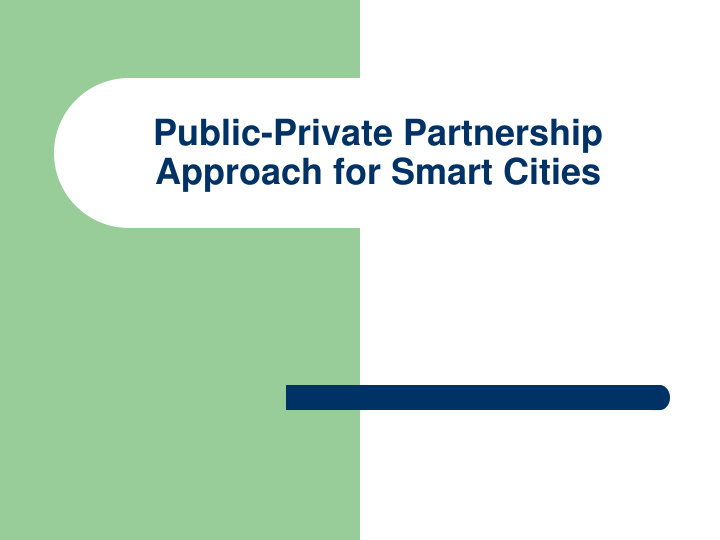



Public-Private Partnership Approach for Smart Cities
Essential elements of a PPP – also applicable to Smart Cities PPPs are commercial transactions between a public and a private party by which the private party: – performs a function traditionally performed by the public sector for an extended period of time; – assumes related construction, commercial, and operational risks; and – receives a benefit in exchange, either by way of public authority paying from its budget, or user fees, or a combination of these. 2 2
Level of risk borne by pvt partner depends on type of contract Management contract - private party shares minimal risks with the public sector Lease contract – in addition, private parties take on operating and collection risks BOT contract - private partners also take on investment and financing risks 3
Best practices in PPPs Competitive bidding is necessary to ensure competition for the market and thus value for money , besides ensuring transparency Two stage bidding process Single bidding parameter at the RfP stage Lowest subsidy that the government must provide – (Viability Gap Funding in India) Lowest annuity payment (BOT – annuity projects) – Lowest initial tariff – 4
PPP in Water and Sewerage sector 5
Prevalence of PPPs in Water and Sewerage sector Water is unique among infra sectors it is essential to life 85% of water utilities are publicly owned and controlled Inherently a difficult sector to enter for the pvt sector because of low cost recovery (~ 20%) and high failure rate 6
Low Cost Recovery in Water Sector 1.8 1.6 Ratio of revenue to costs 1.4 1.2 1 0.8 0.6 0.4 0.2 0 Telecom Gas Power Water 7 7
Water and Sewerage – Challenges and Solutions at the ULB level Uncertainty about condition of assets : This may increase risks and project costs Enhanced Monitoring Period Employee resistance – conditions of service should not deteriorate Decrease in NRW may be a win-win for most stakeholders Political economy of water tariffs Connection instead of consumption subsidies 8
GoI support to ULBs for entering into PPP arrangements Grant support that can be used as equity Model Concession Agreement would be developed covering: – Risk allocation between public and private sectors – Tariff indexation to inflation to mitigate some risks – Performance standards and Coverage targets – Would provide for ULB level flexibility 9
Manila Water Company Metropolitan Waterworks and Sewerage System - government corporation owned the water utility and its assets Private concessionaire chosen through competitive bidding (1997); Bidding parameter - lowest initial tariffs Concession period – 25 years Targets for improvement in service coverage, water quality, service quality and reduction in NRW specified in the contract 10
Success indicators Indicator Before PPP (1997) After PPP (2014) 24-hour potable water 26% 99% supply coverage Number of customers 3.1 million 6.3 million Non-revenue Water 63% 11% (NRW) Volume of water 440 million litres 1.2 billion litres delivered to customers (per day) 11
Summing up - Lessons on structuring PPPs Have the risk allocation right Provide sustainable revenue streams to the private sector NRW and AT&C loss reduction would keep tariff increase manageable State coverage targets, performance standards, NRW reduction target in the contract and hold PPP operator accountable 12
Thank You 13
Recommend
More recommend